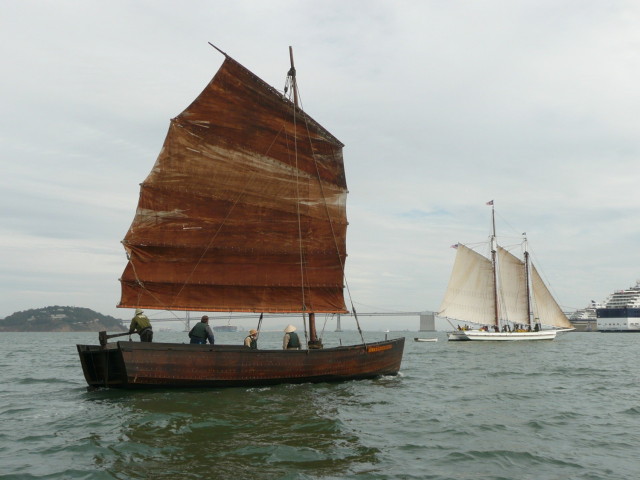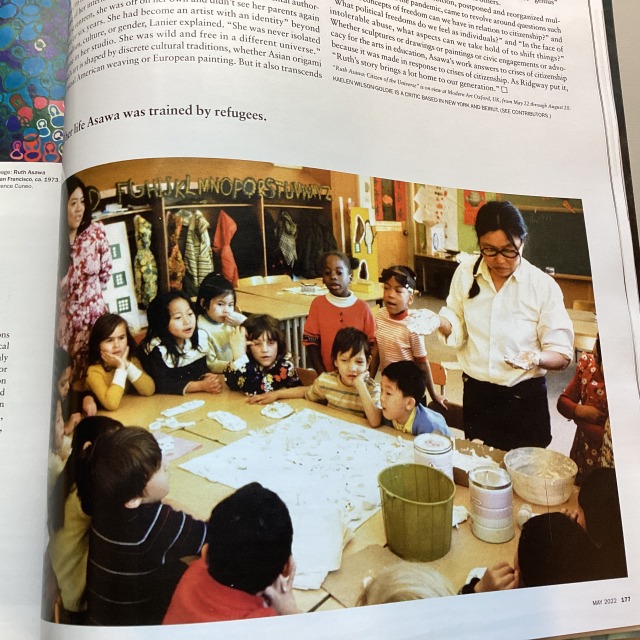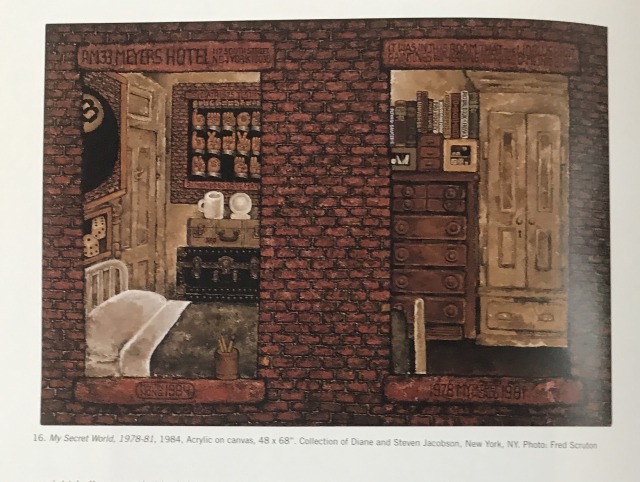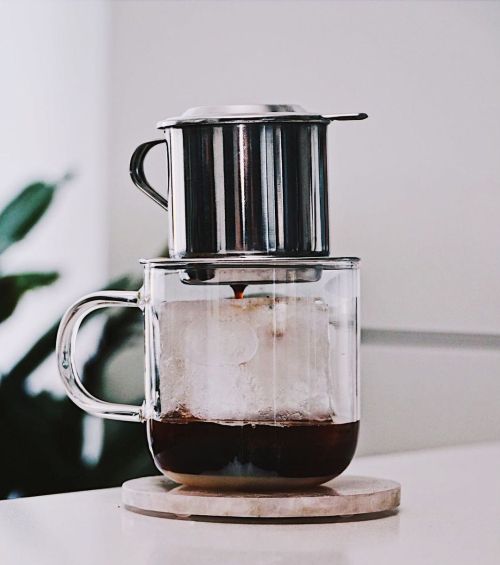#aapiheritagemonth

In celebration of Asian American and Pacific Islander Heritage Month, the Office of National Marine Sanctuaries is launching a series of online interviews delving into AAPI heritage. In partnership with the National Park Service, the story of San Francisco Bay’s fishing camps and the construction of a replica Chinese shrimp junk, like the ones found on San Francisco Bay more than 100 years ago, is our first feature.
Read it here:
https://sanctuaries.noaa.gov/news/may22/building-grace-quan.html

We’re sharing some of our favorite Asian American and Pacific Islander Heritage Month features from recent years. Last year’s web story “The Sampans of Hawaii” discusses the heritage of sampans in Hawaii, a traditional one-sailed Japanese skiff. Sea Queen (pictured) was one of the last pre-war wooden Hawaiian sampans.
#Repost @coco.ono
・・・
Serving you steamy and spicy on our own terms! For every Sacred Wounds show we love presenting new epic creations – here is a sneak peak at videos from your co-producers @coco.ono/@kayla.tange and @drwangnewton.
1. Coco swims in a cosmically delicious psychedelic broth. We’re not tripping, you’re trippin’. But wait, are those mouths?
#breastfeeding #celestialseasoning
2. Dr. Wang is in the house with a newly re-edited music video of his summer banger, “Oh, Hey Baby!” co-produced by @mobiusvanchocstraw. (no joking it’s actually on iTunes etc for purchase). With an all star cast of underground artists @damianxdragon @miss_orchid_mei @thianh_loves Be on the lookout for your very own @coco.ono in a scene of unrequited heterosexual love. #summerwanger
Catch the full versions tomorrow/Saturday! Tix link in bio
#mushroomsoup #spillthesoup #cosmic #psychadelic #dragking #musicvideo #dragkingsofinstagram #ohheybaby #itunes #startasianhealing #aapiheritagemonth #asianamericanartist #summerbanger
https://www.instagram.com/p/CPcO_HQnOMg/?utm_medium=tumblr
#AngelaYee (born 1/3/76) is a #mixed #American radio personality. She hosts the popular morning show #TheBreakfastClub with DJ Envy & Charlamagne tha God. Shes on the Board of Governors of the We Are Family Foundation & for the American Foundation for the University of the West Indies. She is the first-ever ambassador for the New York Public Library system. Since 2019, she has served as the BSE Global Diversity, Inclusion & Community Engagement Ambassador.
Angela was born to a #Chinese father & an #AfroMontserratian mother & raised in Flatbush, Brooklyn. “It was hard growing up in a #Black neighborhood & having a Chinese dad because black people had the most jokes about Asian people. My dad was like the only Chinese person in the neighborhood & they had a lot of jokes—nail salon jokes, Chinese food jokes, a lot of hair store jokes. It was a lot. But I was always very good spirited about it. I think it actually helped prepare me for a career in entertainment.”
“My dad has a huge family. My mom, who’s #WestIndian, is from Montserrat. Shes an only child & does not have a huge family at all. So, it’s interesting, I grew up in Flatbush, which definitely has a large West Indian culture. But, when it came time for holidays, I was with my Chinese side of the family. It’s a blessing now, but when I was younger, it was hard because my Chinese grandparents didn’t accept that my mom was black.”
Her career started with an internship with #WuTang Management assisting the CEO, Divine. She also wrote all the skits on GZA’s 3rd studio album. She then worked for #Eminem’s clothing line which led her to radio. She hosted Lip Service & The Morning After with Angela Yee on Eminem’s radio station, Shade 45, at Sirius. In 2010, she began hosting The Breakfast Club. She also worked as a correspondent for MTV2’s Sucker Free. Other endeavors include managing artists like GZA, Jay Electronica & 360, she owns a Juice Bar chain, Juices for Life, a book club Kickin It From The Stoop to promote reading/literature. Shes also a philanthropist working with Dress For Success, Hairless 4 Her Awareness, Coats for Kids, & Childhood Cancer events just to name a few. #aapiheritagemonth
https://www.instagram.com/p/CdWjbgaOoBs/?igshid=NGJjMDIxMWI=
Post link

RM (@/rkive)’s Instagram story 20220526

BTS will be coming to the White House next week to discuss Asian inclusion and representation!
It’s #companiesthatactuallygiveashit time and in honor of #AAPIHeritageMonth I’m excited to highlight @nguyencoffeesupply
Founded by 1st gen entrepreneur-activist Sahra Nguyen, Nguyen Coffee grows their organic coffee organically at their farm in Da Lat, Vietnam and ship their beans to New York to be roasted in Brooklyn. They even sell adorable #minimalist drip coffee makers (pictured!) that are perfect for camping or travel. ‘We diversify the industry through Vietnamese coffee, elevate resilient robusta as the key to our sustainable coffee future and transform the landscape through economic advancement for both arabica & robusta farmers, globally,’ they say on their website.
Check out @nguyencoffeesupply to learn more about their #ecofriendly practices + to try out their coffee ☕️
#companiesthatactuallygiveashit started when a zero waste retailer blatantly ignored the community’s concerns around inclusivity, and people were looking to find #sustainable and #BIPOC-led brands. Inspired by @zerowastehabesha’s #RepresentationMattersinSustainability series, the goal is to highlight brands that we should all be supporting, and show that this movement isn’t exclusively for white, upper/middle class women. I have a lot of privilege and want to lend my platform to uplifting brands and voices that have been and continue to make a difference in the world. If you know of any brands you’d like to see highlighted, please tag them in the comments below and I’ll add them to the list
[image description: a small metal jar sits atop a glass mug with an ice cube, slowly dripping coffee into the mug.] (at Brooklyn, New York)
https://www.instagram.com/p/CdyG6QFugnP/?igshid=NGJjMDIxMWI=
Post link

Ning from A Magic Steeped in Poison by Judy I. Lin Have I mentioned how much I love the magic system?? Ning’s magic in particular is super fun and I’m so excited for book 2!
 ALT
ALT ALT
ALTBorn in San Francisco, Carlos Villa (1936 – 2013), was an Asian-American of Filipino descent. He once described himself as “a Filipino not born in the Philippines—I am an American, not fully accepted because I am a Filipino in America.”
Villa’s work explored cultural diversity and identity. He lived in Los Angeles and New York in the 1960s, but returned to San Francisco in 1969. There he began teaching art and became involved with multicultural activism.
Image 1: “Tatu”, 1969, ink on itec print, 22”x 18”
Image 2: Black and white photograph of Carlos Villa by Irene Poon, 1997
Leading the way : Asian American artists of the older generation
Photographic portraits and biographical sketches by Irene Poon ; [introduction by Paul Karlstrom ; foreword by Nanying Stella Wong ; historical essay by Lorraine Dong].
Poon, Irene.
Wenham, Mass. : Gordon College, 2001.
108 p. : ill. (some col.), ports. ; 31 cm.
“The creativity and careers of the pioneering artists featured in this publication is the subject of a ground-breaking exhibition at Gordon College. Selected art works and Irene Poon’s photographic portraits of these senior Asian American artists provide an insightful introduction to the Asian American artists who led the way in the decades of the 30s through the 60s. Many of these artists continue to be productive in the 21st century.”–BOOK JACKET.
English
2001
HOLLIS number: 990087693250203941
 ALT
ALT ALT
ALT ALT
ALTIn the tradition of portrait photographers such as Nicholas Nixon and Milton Rogovin, Thomas Holton photographed the Lam family over an extended period of time. Holton was born in Guatemala to a Chinese mother who was a tour guide in Taipei and an American father who was a travel photographer. While he grew up in Manhattan, his maternal grandparents lived in Chinatown, but he always felt like a visitor in their neighborhood.
Holton met Steven and Shirley Lam and their three young children when he was taking publicity photographs for the University Settlement, an organization that offered support to immigrants on the Lower East Side (LES) in Manhattan since 1886. Holton visited the Lam family once a week for more than twelve years and became a part of their household.
Holton’s photographs are closer to street photographs than portraits, capturing the daily lives of the family in a candid manner with emotional sensibility and respect. His “The Lams of the Ludlow Street” project was triggered by Holton’s interrogation of his own cultural identity. Over the years, his work has grown into a close relationship with the family - Holton accompanied the family on a trip to Hong Kong and China in 2004, and the Lams attended Holton’s wedding in 2007. Holton’s project shows the Asian American immigrant experience as well as it is the exploration of a family’s turbulent history.
According to Holton, “My need to see the Lams regularly moved beyond the desire to make new photographs and became akin to visiting family members that I cherish. I return out of love and the knowledge that time is fleeting.”
Thomas Holton : the Lams of Ludlow Street
Texts: Charles Traub, Bonnie Yochelson, Thomas Holton.
Heidelberg : Kehrer, c2015.
96 unnumbered pages : ill. (chiefly col.), ports. ; 23 x 29 cm.
English
HOLLIS number: 990145137490203941
 ALT
ALT ALT
ALTRuth Asawa (1926 – 2013), best known for her looped wire sculptures, worked in a wide range of media, including drawing, painting, lithograph, ceramic, and public art. In the May 2022 issue of Artforum, Kaelen Wilson-Goldie writes in an article entitled “Productive Tensions” that “Asawa worked in a crowded constellation of artmaking modes.”
After the bombing of Pearl Harbor, Asawa and her family were sent to internment camps all over the country. Her father was arrested, and Asawa faced unrelenting prejudice and racism. After nearly completing her training at Milwaukee State Teachers College, Asawa learned that she would not be able to complete the student teaching requirement for her degree, because at the time no schools would allow a Japanese-American student teacher into their classrooms.
In a letter to her daughter Lanier, Asawa wrote, “I no longer want to nurse such wounds.” Then turning to her hands to work on sculpture, “I now want to wrap fingers cut by aluminum shavings, and hands scratched by wire.” To warn her daughter about the prejudice and violence her children may face, Asawa continued, “This attitude has forced me to become a citizen of the universe, by which I grow infinity smaller, than if I belonged to a family, or province, or race.”
Image 1: Black and white photograph of Asawa drawing at her home. Photo: Bob Turner. 1990.
Image 2: Asawa teaching art to elementary school students in San Francisco. Photo: Laurence Cuneo. 1973.
You can find Artforum and many other periodicals in our Reading Room.
 ALT
ALT ALT
ALT“Taking down to street level this time, I wanted to focus in close on some of the endless layers of conflict that has us all bound together… Always locked in, always locked out, winners and losers all…” - Martin Wong
Martin Wong (1946 – 1999) painted urban landscapes such as the tenement apartment buildings in the Lower East Side (LES) where he lived most of his life. He also depicted the lives of people considered underdogs, whether inmates in state prison, graffiti artists, firemen, etc.. Wong was a mostly self-taught Chinese-American artist, who grew up in Chinatown in San Francisco and was openly gay. When he first moved to New York, he lived in a cheap hotel room in exchange for working as a night porter before moving to an apartment in a Hispanic section of the LES known as “Loisaida.”.
“During the ’80s, in an era when Neo-Expressionism was the dominant mode, the largely self-taught artist stood out in subject and style. He sported a long mustache and cowboy duds. He was an openly gay Asian-American man during a period when the city’s Asian diaspora was treated as invisible. (Only 10 years prior, Chinese activists had realized the state census hadn’t bothered to even count hundreds of immigrants living in downtown tenements.) He also made it so that pinning him down on the basis of any one identity was impossible. Wong wasn’t deaf, but he used ASL. He hung out with Puerto Ricans, though he didn’t speak Spanish. He often felt anxious, but he used parody to sublimate his insecurities. In some outsider circles, he was an insider.” (from “Human Instamatic: Martin Wong’s Visionary Paintings of New York continue to Intrigue” by Tessa Solomon, Art in America, June 7, 2021)
Wong labeled himself ethnically as Chino-Latino because his father had Mexican heritage. In his paintings, he meticulously documented his urban environment and the lives lived within it using homoerotic imagery, poetry, and language to explore multiple ethnic, racial, and cultural identities, as well as to celebrated his own queer identity.
Image 1: Front cover featuring “Kato”, 1992, Acrylic on linen.
Image 2: “My Secret World”, 1978-81, Acrylic on canvas.
Sweet oblivion : the urban landscape of Martin Wong
[essays by] Marcia Tucker … [et al.] ; edited by Amy Scholder.
Author / Creator
Wong, Martin
New York : Rizzoli : Distributed by St. Martin’s Press, c1998.
85 p. : col. ill. ; 26 cm.
English
c1998
HOLLIS number: 990078744150203941
 ALT
ALTIn memory of Hung Liu who passed away last August and in honor of Asian American and Pacific Islander Heritage Month.
Hung Liu was a Chinese American artist who once said her goal was “to invent a way of allowing myself to practice as a Chinese artist outside of a Chinese culture.”
Liu was born in 1948 during the revolutionary era in Changchun in northeast China,. Her father was a teacher imprisoned for his involvement in anti-Communist politics. During the Cultural Revolution, she was sent by the government to the countryside to work on farms for “re-education.”
In the 1970s, Liu studied at Beijing Teachers College and Central Academy of Fine Arts, and earned a graduate degree in 1981. But she grew restless with the officially-sanctioned Socialist Realist style and subjects. In 1984, she was given a permission to travel to the United States and enrolled in the MFA program at the University of California, San Diego.
Liu settled permanently in the Bay Area. She started teaching at Mills College in Oakland in 1990, eventually retiring in 2014.
Her death in August 2021 came less than three weeks before the scheduled opening of a career survey, “Hung Liu: Portraits of Promised Lands,” at the National Portrait Gallery in Washington, D.C. She was the first Asian American woman to have a solo exhibition there.
Her work incorporated photo-based images that combined the political and the personal. Many of these images were of figures forgotten by history such as laborers, immigrants, prisoners, and prostitutes. (From “Hung Liu, Artist Who Blended East and West, Is Dead at 73” by Holland Cotter, The New York Times, August 22, 2021)
Image: “Sister Hoods”, 2003, Oil on canvas, 72”x 72”
Summoning ghosts : the art of Hung Liu
Oakland Museum of California.
Liu, Hung, 1948-2021
招魂
Berkeley : University Of California Press, 2013.
216 p. : ill. ; 28 cm.
English
2013.
HOLLIS number: 990136645170203941
Have you even had a seaweed cake? Dr. Isabella (“Izzy”) Aiona Abbott, a renowned algae marine biologist and first Native Hawaiian to receive a PhD in science, wrote a book with a recipe for such a cake to better connect Hawaiian flora and culture.
As a child, her mother taught about the edible Hawaiian seaweeds and instilled in her a love for plants that’s shown through her education, as she earned her bachelors (1941), master’s (1942), and PhD (1950) degrees all in botany.
After being hired as a Biology lecturer at Stanford University in 1960, she had the chance to show her exceptional teaching and research prowess. So much so, that the school promoted her to full professor in 1972 despite not being hired for a tenure-track position.
Authoring 8 books and over 150 publications, Dr. Izzy Abbot was considered the authority of algae of the Pacific Ocean. Her love for botany and her culture was so great, that even after retiring in 1982, she continued to work in ethnobotany at the University of Hawaii.
To read more about this incredible scientist (and for a recipe for seaweed cake), explore the links below!
https://news.stanford.edu/news/2010/december/izzie-abbott-obit-120710.html
#AAPIHM #AAPIHeritageMonth #WomanCrushWednesday #WomenInSTEM #algae #botany #ethnobotany #MarineBiology #IsabellaAionaAbbott #JKXComics
https://www.instagram.com/p/CPV5vFVDpzH/?utm_medium=tumblr
Post link
We’re officially in May which means it’s time to celebrate Asian American and Pacific Islanders in STEM for #AAPIHeritageMonth! Join us over the next to learn about the contributions of four trailblazing #AAPI STEMists!
.
.
.
#AAPIHM #STEM #ScienceIsForEveryone #JKXComics
https://www.instagram.com/p/COYFrUFDb8g/?igshid=1db6humoljc3n
Post link
I’m excited to let everyone know! @fabfilipinobros will be premiering on @hulu! Happy #aapiheritagemonth!!!
https://www.instagram.com/p/Cdb1tIDPzj3/?igshid=NGJjMDIxMWI=
Post link

Happy AAPI heritage month! I’m a Korean American queer artist and I appreciate any support ️




Coasters for the Salut! 6 show at @nucleusportland , opening 6/31! Going with a mushroom/fungi theme with a focus on those used in Asian cuisine. The ones you see here are Reishi, wood ear, bamboo, and straw mushrooms. As the mushrooms grow taller, so too do their containers. Happy AAPI Month~
Happy#AAPIHeritageMonth! This self-care kit for Asian Americans applies all year round (and maybe even for years to come).
The post in this link analyzes how Asian men are being hidden in anti-Asian hate crime data. It’s unbelievable that this is even happening and allowed to continue.
Thisnext post analyzes how journalists are part of the problem (including Asian journalists who uphold and defend racist white-controlled platforms/institutions).
(Please don’t repost or edit my art. Reblogs are always appreciated.)
If you enjoy my comics, please pledge to my Patreon or donate to my Paypal. I lost my publisher for trying to publish these strips, so your support keeps me going until I can find a new publisher/lit agenthttps://twitter.com/Joshua_Luna/status/1134522555744866304
https://patreon.com/joshualuna
https://www.paypal.com/paypalme2/JoshuaLunaComics
Post link
It’s been two years since Image gave me pushback for pitching AMERICANIZASIAN to them. Yesterday I was informed they’ve tweeted #StopAsianHate and put out a list of AAPI creators to support, so I’d like to talk about what that means in the context of my book AMERICANIZASIAN.

For those who don’t know, here’s a summary: The Image partner I pitched to described my comics as “angry,” with no relatable story, and didn’t talk about AsAm issues in the “right way.” They later shifted to legality as their reason to not publish. https://twitter.com/Joshua_Luna/status/1134522555744866304
I know my comics make people uncomfortable. That’s the point—anti-Asian racism is uncomfortable. It’s violent and hateful. You don’t fix it by hand-holding bigots and coddling their feelings. You do it by holding up a mirror to their behavior to let their bigotry speak for itself.
I haven’t spoken much about this, but it’s important to know who’s happy that Image didn’t publish AMERICANIZASIAN: bigots with white supremacist ideologies. I was already getting harassed prior to speaking publicly about Image, but afterwards it turned into a feeding frenzy.
Thousands of Nazis regularly repost and denigrate my work, calling me anti-Asian slurs & other hateful terms—fl*p, ch*nk, g**k, Filipino/island n*gg*r, ricecel/incel, MRAsian, autist, b*tch, etc. They post photos of me to mock my features, and edit swastikas and Hitler onto my comics.
These are loud white supremacists—the ones so-called progressives will easily denounce. But I’ve also been harassed by “quiet” bigots who push to deplatform me through blacklisting and DMs. They used to do it publicly until they realized it tarnished their image as progressives.
All of these reactions prove what I already knew—I *am* talking about AsAm issues in the “right way.” Because if white supremacists and their enablers aren’t deeply bothered about how you talk about race and doing everything they can to stop you, are you even talking about race?
I know I’m not the “good Asian” Image wants to promote. I know they resent me for publicly calling them out. I’d genuinely like to believe this new push for AAPI voices and content shows remorse and growth, but growth can’t happen without owning up to and acknowledging past harm.
So if Image wants to #StopAsianHate, they have to do more than use the hashtag and quietly include me in their list of AAPI creators. They have to acknowledge and rectify how they treated me. Otherwise, it’s hypocritical at best, and a gross attempt at PR damage control at worst.
And the irony is not lost on me that Image is tweeting these things during #AsianPacificHeritageMonth#AAPIHM#APAHM






